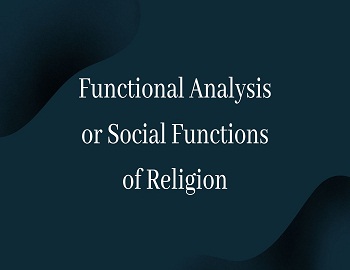Social Functions of Religion:
Religion has three aspects- rituals, beliefs and organization. Rituals deal with religious behaviour. Beliefs deal with the sources as well as the patterns of faith. The organization deals with the mechanism by which religions manage the behaviour, expectations, status and rule of the members concerned.
The following are the universal functions of religion-
(1) Religion is an instrument of social integration and solidarity. Religion serves the following social functions-
- It serves disciplinary and preparatory functions.
- Ceremonial rituals perform a cohesive function.
- It serves as a revitalizing function.
- It also serves as euphoric functions by establishing a pleasant feeling of social well being.
(2) Religion is also a source of conflict. Religious wars have been brutal and bloody because the commitment to religion can lead to a struggle where sometimes many people die. Religious differences within a society often produce tension and conflict.
(3) Religion is a consoler of the dispossessed, hungry or angry.
(4) Religion provides meaning to subjective experiences, it provides meaning in a variety of situations or difficulties. It helps people grapple with an emotional crisis, with death and bereavement with uncertainties and disappointment of all kinds.
(5) Religion is a response to the unknown such as birth, death, dreaming and natural events such as seasons, tides, earthquakes and volcanoes. These mysteries are attributed to supernatural powers.
(6) Religion is one of the means of social control. Religious belief can influence the conduct of the believers through tolerance, forgiveness, patience which are thought in religion. Religion possesses potentialities for regulating man’s conduct to a remarkable extent.
(7) Religion serves a reinforcement function in society to a degree that it teaches and emphasizes the same norms and values that society requires such as ‘Love thy neighbours’. “Though shall not kill, steal or procreate illegitimate children” etc.
(8) Religion stimulates aesthetics. Aesthetic is not exclusively the province of religion, yet one may observe the great architectural monuments, musical compositions and fine works of sculpture and painting use religious themes and subjects.
(9) Religion is the source of social welfare by encouraging people to render a helping hand to those who are in need by preaching “service to human beings is service to God”.
(10) Religion sets moral standards for persons and expects them to comply with them. Religion may also provide standards of values in terms of which institutionalized norms may be critically examined.
(11) Religion is related to the growth and maturation of the individual and his passage through the various age-gradings distinguished by his society.
(12) Religion gives the individual a sense of identity with the distant past and the limitless future. It expands the individual’s ego by making his spirit significant for the universe and the universe significant for him.









Comments (No)